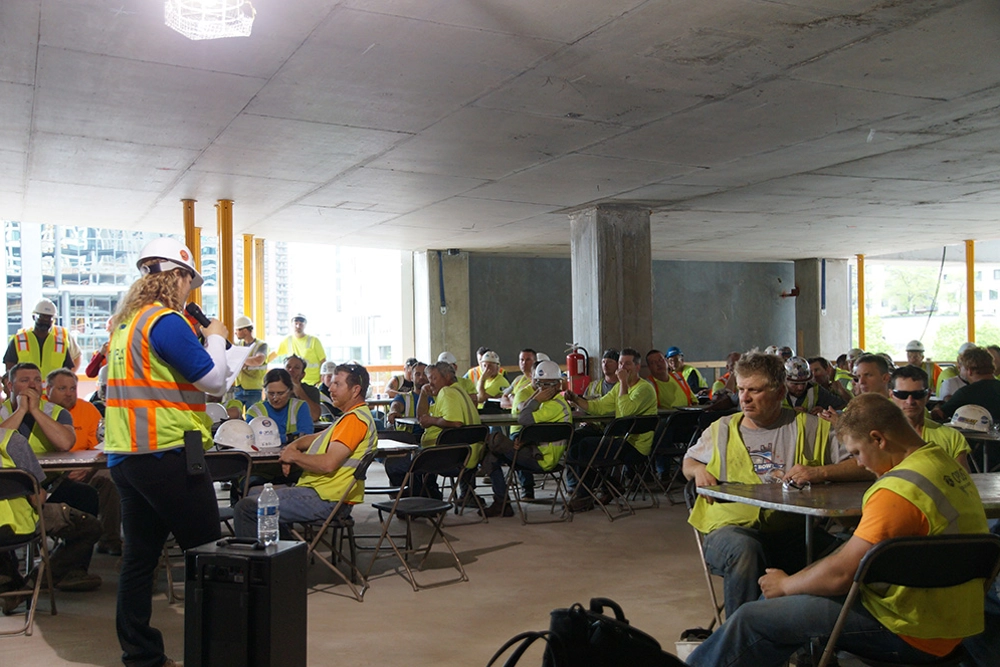6 Factors That Can Lead to Falls on the Job Site
Regional senior safety manager Jessica Keeley spoke about addressing falls on the job site during 365 Nicollet’s Stand Down 4 Safety event.

Falls are one of the biggest hazards faced in the construction industry. Even though safety technology has improved and safe working practices are more commonly part of the work plan, workers are still being severely injured or killed from falling incidents. Where is the construction industry missing the mark when it comes to fall hazards at construction projects? What can the construction industry change so that the risk of falls can be reduced or eliminated?
At a recent Stand Down 4 Safety event at 365 Nicollet in downtown Minneapolis our safety leader shared six factors that can potentially lead to falls on job sites.
Factor #1: Insufficient Planning
It is important to have a fall protection plan. Unfortunately, the need for planning when using fall protection can be overlooked. A plan is ineffective until it is implemented and followed. It is the responsibility of the employer, project superintendent, foremen, safety professional and employee to implement and follow the fall protection plan. Ultimately, the construction industry must strategize when it comes to planning for potential fall hazards and then implement and follow through with the planning.
Factor #2: Lack of Sufficient Training and Communication
Fifteen years ago as an apprentice, the safety manager handed me my first shiny new Exo-Fit harness and six-foot lanyard, but didn’t provide me with any training. Honestly, I had no idea how to size it, wear it, inspect it or even attach my lanyard. These unanswered questions could have created a dangerous situation for me, had I not asked questions to obtain the information that I needed to properly use the equipment. With respect to fall protection training and communication, the construction industry should implement the necessary training with the assumption that no one knows everything, and everyone starts from zero. Proper training and communication is critical to successful fall prevention.
Factor #3: Improper Use of Equipment and Fall Protection
Unfortunately, even when employees are properly trained, equipment and fall protection may be used improperly.
I was once on a site safety visit. From the ground I could see workers on the roof with rope grabs attached to their harnesses. Once I reached the roof, I was able to observe that the roofers were not tied off because their rope grabs were free following them and not connected to an anchorage point. When I questioned them, the workers explained that the work was in the middle of the roof and would be a quick job. Had I not taken action to correct the observed safety issue, this could have potentially resulted in a situation where an “It-Will-Only-Take-Two-Seconds” attitude led to a “It-Happened-So-Fast” accident.
Factor #4: Damaged, Defective and Unmaintained Equipment
Knowing when a tool or equipment should be removed from service is an important factor for safe working conditions. Equipment should be inspected regularly—before each use and tagged and taken out of service if it shows wear and tear. Using equipment past its useful life, especially a lanyard or harness, could result in a fall incident. For the construction industry, a good rule of thumb is: "If in doubt, throw it out." The benefit of an extra week or month of service isn't worth the potential increased fall risk.
Factor #5: Inadequate Anchorage Point
Selecting an inadequate anchorage point is potentially a significant issue. The best harness with the best lanyard or lifeline cannot arrest a fall if unsuitable anchorages are selected.
Factor #6: Assuming that Only Falls from Heights are Dangerous
In the construction industry generally, 70% of falls are from a height, while 30% are due to slips/trips on the same level. Inadequate planning for slips and trips can result because the construction industry may not appreciate the risk of falls for slips and trips as compared to the risk of falls from elevations. Due to the ever-changing and dynamic nature of construction activities, the construction industry faces the consistent challenge to take appropriate action to ensure safe walkways.
***
Ultimately, the safety culture is defined by one's attitudes, beliefs, perceptions and values in the workplace. Safety should not be an afterthought for the construction industry; rather it should be one of the first items to be discussed before work commences.
Article Type: Blog Post
Topics: Minneapolis | Safety


